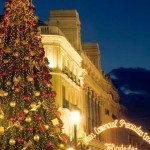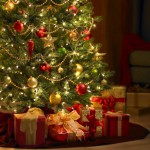The Christmas Tree has become an important symbol and tradition during the holiday season surrounding Christmas. The legend of the Christmas tree has several interesting stories that have been passed down through the centuries. Let us examine some of them and also a brief history of this wonderful decorative practice that has filled our homes with so much joy for such a long time now. 
At the moment of the birth of Christ, one myth says that every tree bore perfect fruit to bear tribute and honor to the Lord except the lowly fir tree. This tree was ashamed of his stature until the Lord approached him and caused him to sparkle with light.
A second enchanting tale claims that a poor family generously took in a needy child near Christmas. This child was in fact the Christ Child. To repay this family for their kindness, the child created a small lit fir tree outside the home to light the way for other weary travelers in need of blessing.
Yet another legend of the Christmas tree states that in the year 722 A.D., St. Boniface cut down an oak tree to prevent heathens from sacrificing a young child at its base. The tale says that a fir tree instantly grew in its place. To the heathens then, this became the Tree of Life which represented Christ’s eternal life. 
A French story from the 13th century described a mammoth fir tree lit with candles that could only be seen on Christmas Eve. The Christ child was at its apex. He had a golden halo about his head.
Over the many years since then, the Christmas tree has continued to be a decorated tree, usually an evergreen conifer such as a spruce, or a pine or a fir. An artificial Christmas tree (now popular among some families) is an object made to resemble such a tree, usually made from polyvinyl chloride(PVC).The tree was traditionally decorated with edibles such as apples, nuts or dates. In the 18th century, it began to be illuminated by candles, which with electrification could also be replaced by Christmas lights. Today, there are a wide variety of traditional ornaments, such as garland, tinsel, and candy canes. An angel or star may be placed at the top of the tree to represent the host of angels or the Star of Bethlehem from the Nativity. 
The custom of the Christmas tree developed in early modern Germany with predecessors that can be traced to the 16th and possibly the 15th century, in which “devout Christians brought decorated trees into their homes.” It acquired popularity beyond Germany during the second half of the 19th century. The Christmas tree has also been known as the “Yule-tree”, especially in discussions of its folkloristic origins.
King Tut never saw a Christmas tree. However, the Egyptians were part of a long line of cultures that treasured and worshipped evergreens. When the winter solstice arrived, they brought green date palm leaves into their homes to symbolize life’s triumph over death.
The Romans celebrated the winter solstice with a fest called Saturnalia in honor of Saturnus, the god of agriculture. They decorated their houses with greens and lights and exchanged gifts. They gave coins for prosperity, pastries for happiness, and lamps to light one’s journey through life.
Centuries ago in Great Britain, woods priests called Druids used evergreens during mysterious winter solstice rituals. The Druids used holly and mistletoe as symbols of eternal life and placed evergreen branches over their doors to keep away evil spirits.
Late in the Middle Ages, Germans and Scandinavians placed evergreen trees inside their homes or just outside their doors to show their hope in the forthcoming spring. Our modern Christmas tree evolved from these early traditions. 
Legend has it that Martin Luther began the tradition of decorating trees to celebrate Christmas. One crisp Christmas Eve, about the year 1500, he was walking through snow-covered woods and was struck by the beauty of a group of small evergreens. Their branches, dusted with snow, shimmered in the moonlight. When he got home, he set up a little fir tree indoors so he could share this story with his children. He decorated it with candles, which he lighted in honor of Christ’s birth.
The Christmas tree tradition most likely came to the United States with Hessian troops during the American Revolution or with German immigrants to Pennsylvania and Ohio.
But the custom spread slowly. The Puritans banned Christmas in New England. Even as late as 1851, a Cleveland minister nearly lost his job because he allowed a tree in his church. Schools in Boston stayed open on Christmas Day through 1870 and sometimes expelled students who stayed home.
The Christmas tree market was born in 1851 when Catskill farmer Mark Carr hauled two ox sleds of evergreens into New York City and sold them all. By 1900, one in five American families had a Christmas tree, and 20 years later, the custom was nearly universal.
Christmas tree farms sprang up during the depression. Nurserymen couldn’t sell their evergreens for landscaping, so they cut them for Christmas trees. Cultivated trees were preferred because they have more symmetrical shape than wild ones.
Six species account for about 90 percent of the nation’s Christmas tree trade. Scotch pine ranks first, comprising about 40 percent of the market, followed by Douglas fir which accounts for about 35 percent. The other big sellers are noble fir, white pine, balsam fir and white spruce.
The Christmas Tree now plays an important part in our American holiday season. At our home, we put our trees up after Thanksgiving and leave them up until at least New Year’s Day. In the past we have often had several full-sized trees in our homes—one in our living room and one in our sunroom. We use both live cut trees and artificial ones. We also decorate in other rooms of our house and in our yard with smaller versions. These areas include our dining room, the gazebo in our front yard, and our front porch. Our living room tree is very special and consists of very unique ornaments we have collected for many years. I also adorn it with lace ribbons, garland, and baby’s breath. At the top of our main tree is a beautiful angel that has guarded over our tree and holiday festivities for many years now. Our gifts are placed under the tree and opened on Christmas Day. I cannot imagine a year during Christmas without at least one tree. Even in December 2011 when I lived in Egypt, I had to have a small tree. It was not a great tree but in my eyes it was still beautiful because of what it represented to me………..
Randi D. Ward
December 6, 2013




